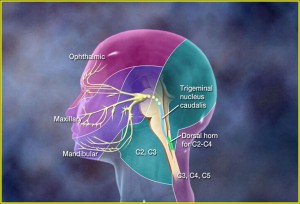TRIGEMINAL NERVE is the 5th and the largest cranial nerve. It derives its name from the Latin words “tres†means three and “geminus†means born together (i.e. three born together), hence the name Trigeminal. It innervates the structures derived from the 1st branchial arch. It mixed nerve i.e. it has a large sensory and a small motor root.
 LEVELS OF NEURONS:
1ST ORDER: These are the receptor neurons; they are the derivatives of the neural crest. Their cell bodies lie in the sensory ganglia. The peripheral branch innervates receptor organs and the central branch enters the brainstem. The area of the skin innervated y a single root is called a dermatome.
2ND ORDER: They have their cell bodies in the embryonic alar plate, derived from the neural tube. Their axons decussate (cross the midline). They ascent in tracts, reach the thalamus, where they terminate in specific sensory nuclei.
3rd ORDER: Have cell bodies in the thalamus. Axons of these thalamic neurons pass to the primary somatosensory cortex of the parietal lobe.
Â
Sensory innervations of face by trigeminal nerve are based upon embryologic origins:
•     Frontonasal prominence : ophthalmic division
•     Maxillary prominence      : maxillary division
•     Mandibular prominence  : mandibular division
CLINICAL CONSIDERATIONS
LESIONS OF TRIGEMINAL NERVE
Supranuclear Lesions:-
•     The motor nuclei receive bilateral innervation.
•     Unilateral lesion (e.g. a hemispheric stroke) causes no discernable weakness of the muscles.
•     Bilateral lesion (e.g. a upper brain stem lesion) causes psedobulbar palsy with dysarthria, dysphagia and a brisk jaw jerk reflex.
Nuclear Lesions:-
•     Lesions involving the motor nucleus will cause ipsilateral muscle weakness and wasting.
•     Masseter and temporalis can be seen and felt to be wasted on jaw closure.
•     On jaw opening the jaw deviates to the affected side because of the weakness of pterygoid muscles.
Peripheral Lesions:-
Numerous pathologies can affect the intracranial part of the trigeminal nerve complex e.g. tumors, infections, Paget’s disease, trauma, aneurysms etc.
Peripheral branches of the 3 main divisions may be damaged by surgery or trauma resulting in areas of sensory disturbance and sometimes accompanied by a continuous neuralgic pain. The most commonly affected are supraorbital, infraorbital and inferior alveolar branches.
Cranial Nerve Test:
The lesion of the trigeminal nerve may produce one or more of the following –
•     There may be anesthesia over the sensory distribution. Sensation is tested for light touch with a bit of cotton; pain perception is tested with a pin.
•     There may be paralysis of the muscles and flaccidity of the floor of the mouth and soft palate.
•     Loss of corneal reflex.
•     Loss of jaw jerk reflex.
•     Hyperacusis due to paralysis of the tensor tympani muscle of middle ear.
Â
TRIGEMINAL NEURALGIA
It is the most commonly encountered disorder of the TG nerve. It is usually seen after 50 yrs of age. It is more common in women. Right side of face is frequently involved. Pain is unilateral, most often in V2 & V3. It is often misdiagnosed.
Clinical Features:-
•       Typically severe lancinating pain occurs in paroxysms.
•       Each episode lasting for only a few seconds.
•       The frequency of attacks- several in a minute to days.
•       Between the paroxysms, particularly if they are frequent, a dull background ache may be experienced.
•     The stabs of pain may be accompanied by involuntary contraction of the facial muscles, hence the name ‘tic douloureux’.
•     Patients identify one or more triggers to their attacks. These include touching a very specific part of their face, a cold draught, swallowing, brushing etc., tactile triggers may prevent the patient from washing his face, shaving, or even brushing.
•     The maxillary and mandibular divisions are most commonly involved.
•     Ophthalmic division involved in less than 10% of cases.
•     All three divisions 1 %
•     Bilateral cases 3%
Sweet in 1967, diagnostic criteria for Trigeminal Neuralgia
- The pain is paroxysmal.
- The pain may be provoked by light touch to the face (trigger zones).
- The pain is confined to the trigeminal distribution.
- The pain is unilateral.
- The clinical sensory examination is normal.
Etiology:
IDIOPATHIC/CLASSICAL/TYPICAL:
•     Attacks are stereotyped in the individual patient.
•     There is no clinically evident neurological deficit.
•     Not attributed to another disorder.
•     Secondary to a vascular loop that compresses the trigeminal nerve a few mm proximal to the pons.
•     Superior cerebellar artery is the most commonly involved artery followed by anterior inferior cerebellar, basilar and pontine arteries.
 SYMPTOMATIC / SECONDARY-
•      A causative lesion, other than vascular compression, has been demonstrated by special investigations and/or posterior fossa exploration.
Differential diagnosis:
A substantial amount of cases diagnosed initially as trigeminal neuralgia prove to have other conditions. By far the most common area of confusion centers around teeth.
Facial pain due to-
•      Dental disease –Abscess (periapical or periodontal), but the overall features and the absence of trigger zones readily distinguish it from trigeminal neuralgia.
•     Sinusitis
•     Eye disease
•     Costen’s syndrome
•     Maladjustment of bite
•     Brain stem lesions
•     Post herpetic neuralgia
•     Tabes dorsalis
•     Atypical facial pain
•     Cluster headache
•     Glossopharyngeal neuralgia
•     Angina
Â
Treatment of Trigeminal Neuralgia
•     Medical
–    Carbamazepine
–    Baclofen / Clonezepam
–    Phenytoin
–    Gabapentin
–     Sodium valproate
Carbamazepine gives good and sometimes excellent relief in up to 70% of the patients. Starting dose is 100 mg twice daily, as required over a period of 1 -2 weeks to either the lowest effective dose or the maximal tolerable dose. If Carbamazepine does not work the other drugs can be tried.
In some patients even very determined drug treatment prove unsuccessful, whereas in others there may be only partial or complete relief but only at the cost of unacceptable side-effects. In such circumstances some form of surgical intervention should be considered.
•     Surgical
–    Peripheral injections
–    Peripheral neurectomy
–    Microvascular Decompression
–    Rhizotomy
                              Thermocoagulation (65°)
                              Cryotherapy (Nitrous oxide cryo probe is used)
                              glycerol
                              percutaneous balloon decompression
                              gamma knife stereotactic radio surgery
–    Intracranial procedures
